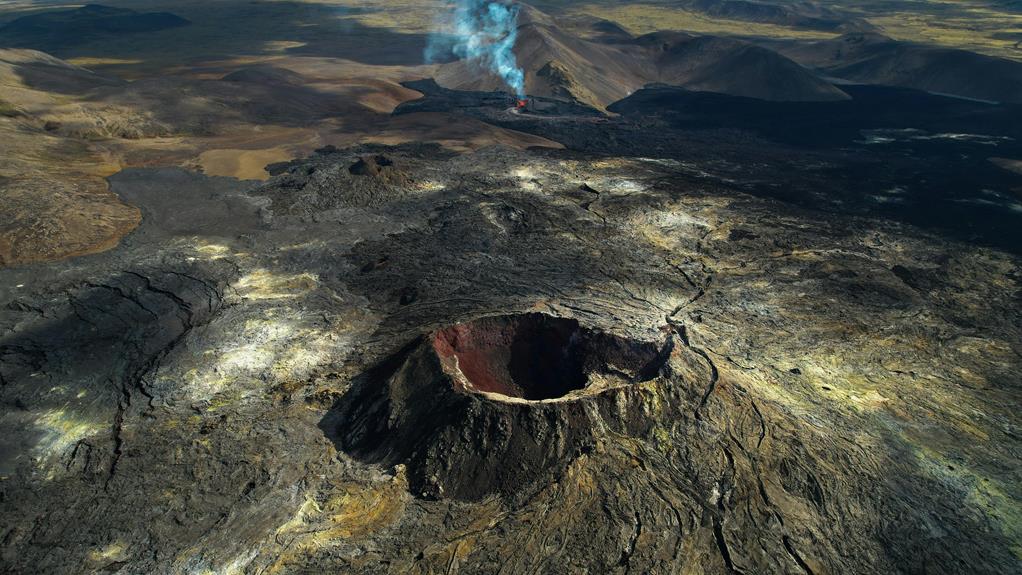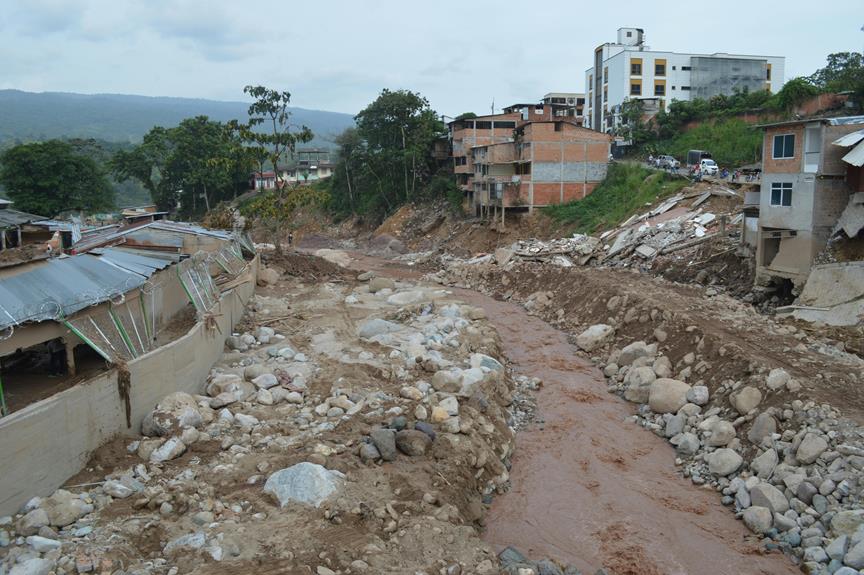Nestled in the Sunda Strait, Krakatoa stands as a testament to the sheer power of nature, with its turbulent history marked by cataclysmic eruptions that reverberated across the globe. The tales of devastation and ecological aftermath paint a compelling narrative of resilience and adaptation. As we explore the intricate dance between human intervention and environmental forces in this region, one cannot help but ponder the future implications and delicate balance that define our existence in the shadow of this iconic volcano.
Key Takeaways
- Krakatoa is a volcanic island located in the Sunda Strait between Java and Sumatra.
- The geological formation is a stratovolcano at the boundary of the Eurasian and Indo-Australian Plates.
- Historical eruptions, notably in 1883 and 535 AD, have had global impacts on climate.
- Modern monitoring techniques aid in predicting eruptions for risk mitigation.
- Conservation efforts focus on ecological recovery, community engagement, and responsible tourism practices.
Location and Geography
What geographical features define the location of Krakatoa in Indonesia?
Krakatoa, a volcanic island situated in the Sunda Strait between Java and Sumatra, is part of the Indonesian archipelago. Its precise coordinates are approximately 6.10° S latitude and 105.42° E longitude. The geography of Krakatoa is characterized by its volcanic formation, with the island being a result of various volcanic activities over time.
Krakatoa is part of a volcanic island arc that forms the subduction zone between the Eurasian Plate and the Indo-Australian Plate. This geological setting contributes to the intense volcanic activity in the region. The island itself is a stratovolcano, a conical volcano built up by many layers of hardened lava, pumice, tephra, and volcanic ash. These layers are a reflection of Krakatoa's explosive past and the powerful eruptions it has experienced.
The volcanic formation of Krakatoa has shaped not only the island itself but also the surrounding marine environment. The violent eruptions of the past have led to the collapse and formation of calderas, creating a unique underwater topography. The presence of these submerged volcanic structures adds to the allure of the Krakatoa region for scientists, divers, and tourists alike, offering a window into the island's tumultuous volcanic history.
Historical Eruptions
Throughout its history, Krakatoa has been the site of several significant volcanic eruptions that have had far-reaching consequences. The causes of these eruptions are rooted in the complex geological processes occurring beneath the surface of the Earth. Krakatoa is located at the boundary of the Eurasian, Indo-Australian, and Pacific tectonic plates, making it prone to volcanic activity due to the intense subduction and volcanic arc formation in the region.
One of the most famous eruptions of Krakatoa occurred in 1883 when the volcano released a series of powerful explosions, triggering tsunamis that reached heights of over 30 meters. The consequences of this eruption were catastrophic, with over 36,000 people losing their lives and the surrounding region being plunged into darkness due to the massive ash cloud that spread across the sky.
Another significant eruption took place in 535 AD, causing a volcanic winter that led to widespread crop failures and famine across the globe. The consequences of historical eruptions at Krakatoa serve as a stark reminder of the power and unpredictability of volcanic activity, highlighting the importance of monitoring and studying these natural phenomena to mitigate risks and protect vulnerable populations.
Impact on Global Climate
The historical eruptions of Krakatoa have had a significant impact on the global climate, shaping the Earth's atmospheric conditions in significant ways. The eruption of Krakatoa in 1883 is one of the most well-documented events that showcases the influence volcanic activity can have on climate change. The release of massive amounts of sulfur dioxide during the eruption led to the formation of sulfuric acid droplets in the stratosphere. These droplets acted as a barrier, reflecting sunlight away from the Earth's surface, resulting in a cooling effect on the planet.
The atmospheric effects of the Krakatoa eruption were far-reaching. The following year, 1884, was known as the 'Year Without a Summer' in various parts of the world due to the cooling impact of the volcanic emissions. The global climate experienced disruptions in rainfall patterns, leading to agricultural failures and food shortages in some regions.
Moreover, the eruption of Krakatoa contributed to stunning atmospheric optical effects such as vibrant sunsets due to the scattering of light by the sulfuric acid droplets. Scientists continue to study historical volcanic events like Krakatoa to understand better the complex interactions between volcanic activity and climate change, highlighting the significant role that volcanic eruptions play in shaping our planet's atmospheric dynamics.
Modern-Day Volcanic Activity
In the domain of contemporary geoscience, monitoring and analyzing modern-day volcanic activity serves as a pivotal aspect of understanding Earth's dynamic geological processes. Scientific research on modern volcanic activity involves the use of advanced technologies such as satellite monitoring, seismometers, gas analyzers, and drones to track changes in volcanic behavior. By studying these activities, scientists can better predict eruptions, assess potential hazards, and contribute to emergency preparedness efforts in vulnerable regions.
One significant focus of scientific research is to understand the factors that influence volcanic eruptions. This includes investigating the magma composition, gas emissions, and seismic activity associated with volcanoes. By analyzing these factors, researchers can gain insights into the eruption patterns of different volcanoes, helping to mitigate risks and protect communities living nearby.
Emergency preparedness is a critical outcome of studying modern volcanic activity. Through continuous monitoring and research, authorities can establish early warning systems, evacuation plans, and response strategies to minimize the impact of volcanic eruptions on human lives and infrastructure. This preparedness also involves educating the public about volcanic risks and ensuring that communities are equipped to respond effectively in case of an eruption.
Ecological Recovery
Exploring the intricate process of ecological recovery following volcanic eruptions involves analyzing the resilience of ecosystems in regenerating and adapting to the altered landscape. Biodiversity restoration post-Krakatoa's eruptions is essential for the recovery of the region's ecosystems. Plant succession plays an important role in this process, as pioneer species colonize the barren terrain, gradually paving the way for more complex vegetation to establish. This succession not only aids in stabilizing the soil but also creates a foundation for the return of diverse plant and animal species.
Wildlife habitat restoration is another key aspect of ecological recovery around Krakatoa. The reestablishment of suitable habitats for various species is crucial for the survival and proliferation of native fauna. Community involvement is instrumental in this phase, as local knowledge and engagement can greatly contribute to the success of conservation efforts. Involving communities in the restoration process not only fosters a sense of stewardship but also ensures that the initiatives are sustainable in the long term.
As the ecosystems around Krakatoa continue to recover, monitoring and adaptive management strategies are essential to track progress and address any challenges that may arise. By understanding the dynamics of ecological recovery and implementing measures to support biodiversity restoration and wildlife habitat, the region can gradually regain its ecological balance and resilience in the aftermath of the volcanic eruptions.
Visitor Experience
Efficient management of visitor interactions within the post-eruption ecological landscape surrounding Krakatoa is paramount for ensuring a balanced and sustainable visitor experience. The site's unique natural setting and cultural significance make it a popular destination for tourists, researchers, and nature enthusiasts. To enhance visitor interactions, it is vital to implement strategies that minimize negative impacts on the environment while maximizing the educational and recreational benefits for visitors.
Visitor interaction within the Krakatoa region should be guided by principles of conservation and preservation. This includes establishing designated trails and viewing areas to prevent habitat destruction and disturbance to wildlife. Interpretive signage can educate visitors about the ecological recovery process and the cultural heritage associated with the area, fostering a deeper appreciation for the site's significance.
Furthermore, promoting responsible tourism practices, such as waste management and minimizing carbon footprints, can help mitigate the environmental impact of increased visitor traffic. Engaging local communities in ecotourism initiatives can also contribute to the sustainable development of the region while preserving its cultural identity.
Conservation Efforts
Several initiatives have been implemented to safeguard and restore the ecological balance in the Krakatoa region, focusing on conservation efforts that prioritize habitat protection and species preservation. Community engagement plays an important role in these efforts, with local communities actively participating in conservation projects. By involving the community, a sense of ownership and responsibility is fostered, leading to more sustainable conservation outcomes.
One key aspect of conservation efforts in Krakatoa is wildlife preservation. Endangered species such as the Javan Rhino and Sumatran Tiger are the focus of conservation programs aimed at protecting their habitats and ensuring their survival. Conservationists work closely with local authorities and communities to establish protected areas and implement anti-poaching measures to safeguard these vulnerable species.
Moreover, reforestation projects are underway to restore degraded habitats and create corridors for wildlife movement. By planting native tree species and restoring natural vegetation, these efforts aim to enhance biodiversity and provide essential habitats for a variety of plant and animal species.
Frequently Asked Questions
How Do Local Communities Prepare for Potential Volcanic Eruptions?
Community readiness for potential volcanic eruptions involves several key components:
- Developing thorough evacuation plans. Local communities must establish early warning systems, conduct regular drills, and educate residents on evacuation procedures.
- Designating safe zones and routes for evacuation to minimize risks.
- Collaborating with government agencies and emergency services for effective response coordination.
- Continuous monitoring of volcanic activity and regular updates on preparedness measures to enhance community resilience to potential volcanic threats.
Are There Any Unique Species of Wildlife That Have Adapted to Krakatoa's Environment?
In environments subject to natural selection pressures, wildlife adaptation and evolution are essential for survival. Unique species often develop specialized traits that enhance their ability to thrive in specific habitats.
Biodiversity plays a key role in ecosystems, fostering resilience to environmental changes. Understanding how wildlife adapts and evolves to its surroundings can provide valuable insights into the intricate interplay between species and their environments.
What Measures Are in Place to Monitor Volcanic Activity in Real-Time?
Volcanic predictions and real-time monitoring systems play an essential role in mitigating potential hazards associated with volcanic activity.
Through a network of seismometers, gas sensors, and satellite imagery, scientists can monitor ground movement, gas emissions, and changes in volcanic morphology.
These advanced technologies allow for early detection of volcanic unrest, providing important data for decision-makers to implement timely evacuation plans and other necessary precautions to guarantee public safety.
Can Visitors Witness Ongoing Ecological Recovery Efforts on the Island?
Efforts are being made to restore the ecological balance on the island through ongoing ecological restoration projects. These initiatives aim to engage local communities in the restoration process, fostering community engagement and awareness.
Sustainable tourism practices are being encouraged to minimize tourist impact on the delicate ecosystem. Visitors may have the opportunity to witness firsthand the positive outcomes of these restoration efforts, providing a unique educational experience on ecological recovery.
How Do Conservation Efforts on Krakatoa Benefit Surrounding Marine Ecosystems?
Ecosystem restoration efforts on islands can have significant positive impacts on surrounding marine ecosystems. By enhancing habitat quality and biodiversity on land, conservation initiatives can indirectly benefit marine biodiversity. Improved terrestrial conditions can lead to better water quality, reduced pollution runoff, and increased availability of resources for marine species.
This interconnectedness underscores the importance of integrated conservation strategies that consider the holistic health of both terrestrial and marine environments.
Conclusion
To sum up, Krakatoa's historical eruptions have had a significant impact on global climate patterns. Monitoring modern volcanic activity is vital for prediction and mitigation of risks.
Efforts in ecological recovery and conservation play an essential role in preserving the natural and cultural heritage of the region. As the adage goes, 'The earth does not belong to us; we belong to the earth.'
It is imperative to continue studying and safeguarding Krakatoa for future generations.


